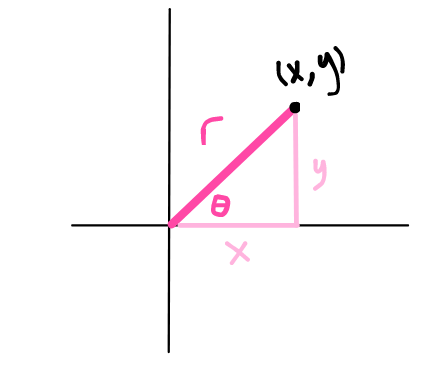Complex Analysis
Peter Zenz - Fall 2022
Feel free to copy, reuse, and distribute any part of these notes. Please email ian [at] beanway [dot] me with any errors!
Lecture 1 - Introduction, Complex Numbers, and Polar Coordinates
Introduction and Overview

Complex Definitions
- Addition: \((a + bi) + (c + di) = (a + c) + (b + d)i\)
- Multiplication: \( (a + bi)(c + di) = ac - bd + i(da + bc) \)
- Modulus/Absolute Value: \( |z| = |x + yi| := \sqrt{x^2 + y^2} \)
- Division: For \(z = x + yi \neq 0\), we want an \(a + bi\) such that $$ (x + yi)(a + bi) = 1. $$ \(a + bi = \frac{1}{x + yi} \cdot \frac{x - yi}{x - yi} = \frac{x-yi}{x^2 + y^2}\), so \(a=\frac{x}{x^2+y^2}\) and \(b=\frac{-y}{x^2+y^2}\).
- Complex Conjugation: \( \overline{x + yi} = x - yi \)
- This conjugation has some nice properties:
- \(\bar{\bar{z}} = z\)
- \(\overline{z+w} = \overline{z} + \overline{w}\)
- \(\overline{zw} = \overline{z} \cdot \overline{w} \)
- \(|z| = |\overline{z}|\)
- \( |z|^2 = z\overline{z} \)
- \( Re(z) = \frac{z + \overline{z}}{z} \;\; ; \;\;\ Im(z) = \frac{z - \overline{z}}{z} \)
- \( |zw| = |z||w| \)

Polar Coordinates

Lecture 2 — Polar Coordinates and Complex Exponentials
Complex Multiplication Geometrically
Facts from Real Analysis
- For every \( r \in \mathbb{R}, \,\, \displaystyle\sum_{n=0}^{\infty}\frac{r^n}{n!} \) converges.
- If \( a_n \in \mathbb{C} \) and \( \displaystyle\sum_{n=0}^{\infty}|a_n| \) converges, then \( \displaystyle\sum_{n=0}^{\infty} a_n \) converges.
- If \( \displaystyle\sum_{n=0}^{\infty} a_n \) and \( \displaystyle\sum_{n=0}^{\infty} b_n \) converge absolutely, then \( \displaystyle\sum_{n=0}^{\infty}\displaystyle\sum_{k=0}^{n}a_nb_{n-k}\) converges to \( \displaystyle\sum_{n=0}^{\infty}a_n\displaystyle\sum_{m=0}^{\infty}b_m \).
Complex Exponentials
Lecture 3 — Complex Exponentials, Logarithms, and Power Functions
- \( |e^{i\theta}| = 1 = \sqrt{\cos^2\theta + \sin^2\theta} \)
- \( e^{\overline{i\theta}} = e^{-i\theta} \)
- \( \frac{1}{e^{i\theta}} = e^{-i\theta} \)
Proving Trig Identities From Exponentials
Complex Logarithms
We want to invert \( e^z \). There's a problem: \( e^z \) is not injective. (Compare this relationship with \(\sin x\) and \(\arcsin x\) restricted to \([-1, 1]\).) Here's how we can do it:
For \(z \neq 0 \in \mathbb{C}\), we define $$\begin{align} \log z &= \log |z| + arg(z) \\ &= \log |z| + iArg(z) + 2\pi ik. \end{align}$$
Values of \(\log z\) are complex numbers such that \(e^w = z\) $$\begin{align} e^2 = e^{\log z} &= e^{\log |z|}e^{iArg(z)}e^{2\pi ik}\\ &= |z| \cdot e^{iArg(z)} \cdot 1 = z. \end{align}$$
On the other hand, suppose \(w = u + iv\) such that \(e^2 = z = re^{i\theta}\). Then, $$\begin{align} r = |z| = e^u \Rightarrow u = \log |z|\;\; \text{ and }\;\; v = arg (z). \end{align}$$
The principal value of \( \log z \) is defined by \( \text{Log }(z) = \log |z| + iArg(z). \)
Note: \(\log z\) is a multivalued function, but \(\text{Log } z\) is a single-valued function with values in the horizontal strip \(-\pi < Im(z) \leq \pi\).
Compute \(\text{Log } i\): $$\begin{align} \text{Log } i &= \log |i| + iArg(i) \\ &= log(1) + i\frac{\pi}{2} &= \frac{i\pi}{2} \end{align}$$
Power Functions
For \(z,\,\alpha \in \mathbb{C}\) where \(z \neq 0\), we can define a general power function as $$ z^\alpha := e^{\alpha\log z}. $$ So, $$ e^{\alpha(\log |z| + iArg(z) + 2\pi ik)}. $$
So we can now use exponents with complex numbers more generally. But we should be careful! Because things don't behave exactly like the reals here. The power rule of distribution doesn't hold, i.e. $$ z^\alpha z^\beta \neq z^{\alpha + \beta}. $$
Lecture 4 —
Complex Roots
We want some \( w \in \mathbb{C} \) such that \( w^2 = z \). We'll write \(z = re^{i\theta}\) and \( w = se^{i\phi} \). Then, $$ w^2 = s^2e^{i2\phi} = re^{i\theta}. $$ This means that $$ s^2 = r \;\;\;\; \text{and} \;\;\;\; 2\phi = \theta. $$ So we conclude that \( w = \sqrt{r}e^{i\theta / 2} \). But there's another solution: \( w = \sqrt{r}e^{i(\frac{\theta}{2} + \pi)} \). Note that there are two solutions.
In general, an \( n^{\text{th}} \) root has \(n\) solutions in \(\mathbb{C}\).
General \(n^{\text{th}}\) Root
We want \(w\in\mathbb{C}\) where \(w^n = z\). Well we
have
$$\begin{align} \Leftrightarrow& s^ne^{in\phi} = re^{i\theta}\\ \Leftrightarrow& s^n = r
\;\;\;\;\text{and}\;\;\;\;n\phi = \theta + 2\pi k\end{align}$$
So, \(s = \sqrt[n]{r}\) and \( \phi = \frac{\theta}{n} + \frac{2\pi k}{n} \) with \( k =
0,\dots,n-1 \).
Compute the square root of \( z = -1 - i \).
Well, \( -1 - i = \sqrt{2}e^{i\frac{5\pi}{4}}
\). We get \(w_1 = \sqrt[4]{2}e^{i\frac{5\pi}{8}}\) and \( w_2 = \sqrt[4]{2}e^{i\frac{13\pi}{8}}
\).
Complex Trigonometric Functions